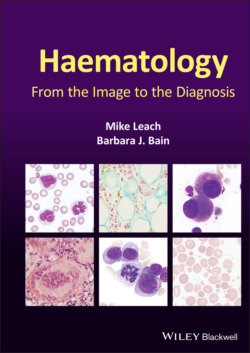Читать книгу Haematology - Barbara J. Bain, Irene Roberts - Страница 29
Оглавление20 Hairy cell leukaemia
A 43‐year‐old man presented with fatigue and early satiety. His automated full blood count showed Hb 75 g/l, WBC 15.3 × 109/l, lymphocytes 3.62 × 109/l, neutrophils 0.6 × 109/l, monocytes 11.1 × 109/l and platelets 32 × 109/l. He had an easily palpable spleen without lymphadenopathy. The blood film showed plentiful hairy cells with a typical round or ovoid nucleus, absent nucleoli and pale blue fluffy irregular cytoplasm (top images ×100 objective): some cells showed an indented peanut‐shaped nucleus (top right). The marrow trephine biopsy sections (×50) showed a diffuse infiltrate of lymphoid cells with voluminous cytoplasm (bottom left, H&E), generating grade 1–2/3 fibrosis (bottom centre, reticulin stain) with strong uniform CD20 positivity (bottom right, immunoperoxidase). Flow cytometric studies on the peripheral blood lymphoid cells indicated a CD19+, CD20+, CD79b+, CD22+, FMC7+, HLA‐DR+, CD10+, CD11c+, CD25+, CD103+, CD123+ and lambda‐restricted immunophenotype. The diagnosis is hairy cell leukaemia (HCL), a rare mature B‐cell neoplasm typically causing splenomegaly and cytopenias, most notably neutropenia and monocytopenia (note that the automated analyser has miscounted the hairy cells as monocytes). The disease typically infiltrates the bone marrow in a diffuse pattern with associated fibrosis. Bone marrow aspirates are typically ‘dry’ so a careful assessment of the blood film is frequently useful in anticipating this condition.
The images on the facing page are of peripheral blood from a patient with splenic marginal zone lymphoma (SMZL). There are some morphological similarities to HCL but the cells here are a little smaller and have less voluminous cytoplasm showing fronds and tufts (×100). The cytoplasmic border is somewhat easier to define. The cells here showed a mature pan‐B phenotype with CD11c positivity whilst CD25, CD103 and CD123 were not expressed.
The pattern of bone marrow infiltration also differs in SMZL. This condition can show a degree of interstitial infiltration but it more typically demonstrates focal nodular, paratrabecular and intrasinusoidal disease.
Hairy cell leukaemia variant, in which the neoplastic cells have prominent nucleoli, must also be distinguished from HCL. Despite the name, this condition has no close relationship to hairy cell leukaemia.
MCQ
1 Hairy cell leukaemia:Can be distinguished from chronic lymphocytic leukaemia on the basis of CD200 expressionIs associated with a BRAF V600E mutation in the majority of patientsIs best distinguished from hairy cell leukaemia variant by expression of CD25, CD123 and CD200Requires assessment of tartrate‐resistant acid phosphatase (TRAP) activity for a firm diagnosisUsually has collagen fibrosisFor answers and discussion, see page 206.
